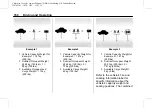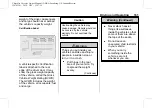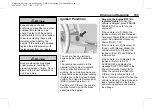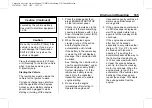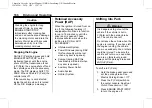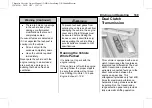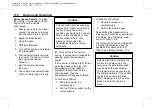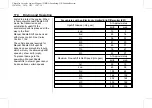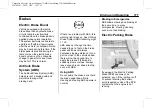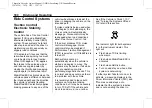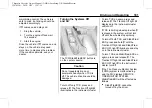
Chevrolet Corvette Owner Manual (GMNA-Localizing-U.S./Canada/Mexico-
12470550) - 2020 - CRC - 12/17/19
172
Driving and Operating
Driver Leaves Vehicle :
To place
the vehicle in N (Neutral) with the
engine off and the vehicle
unoccupied:
1. Ensure the vehicle is on level
ground, the engine is running
and the vehicle is in P (Park).
2. Apply the brake pedal.
3. Open the door.
4. Shift to N (Neutral).
5. Turn off the engine and release
the brake pedal.
6. The indicator should continue
to show N. If it does not, start
the engine and repeat
Steps 2
–
5.
7. Exit the vehicle and close
the door.
8. The vehicle may automatically
shift to P (Park) upon re-entry.
Caution
A transmission hot message may
display if the transmission fluid is
too hot. Driving under this
condition can damage the vehicle.
Stop and idle the engine to cool
the transmission fluid. This
message clears when the
transmission fluid has cooled
sufficiently.
D :
This position is for normal
driving. If more power is needed for
passing, press the accelerator
pedal.
If the vehicle is shifted into D (Drive)
while the speed is too high, the
transmission will get ready to
engage D (Drive). Reduce the
vehicle speed, then the
transmission will engage D (Drive).
To shift into D (Drive):
1. Bring the vehicle to a
complete stop.
2. Pull the D (Drive) switch on the
center console.
To shift out of D (Drive):
1. Bring the vehicle to a
complete stop.
2. Shift to the desired gear.
Downshifting the transmission in
slippery road conditions could result
in skidding. See
“
Skidding
”
under
.
The transmission can be shifted like
a manual transmission using the
paddle shift controls while in D
(Drive). See
.
Caution
Spinning the tires or holding the
vehicle in one place on a hill
using only the accelerator pedal
may damage the transmission.
The repair will not be covered by
the vehicle warranty. If the vehicle
is stuck, do not spin the tires.
When stopping on a hill, use the
brakes to hold the vehicle in
place.



